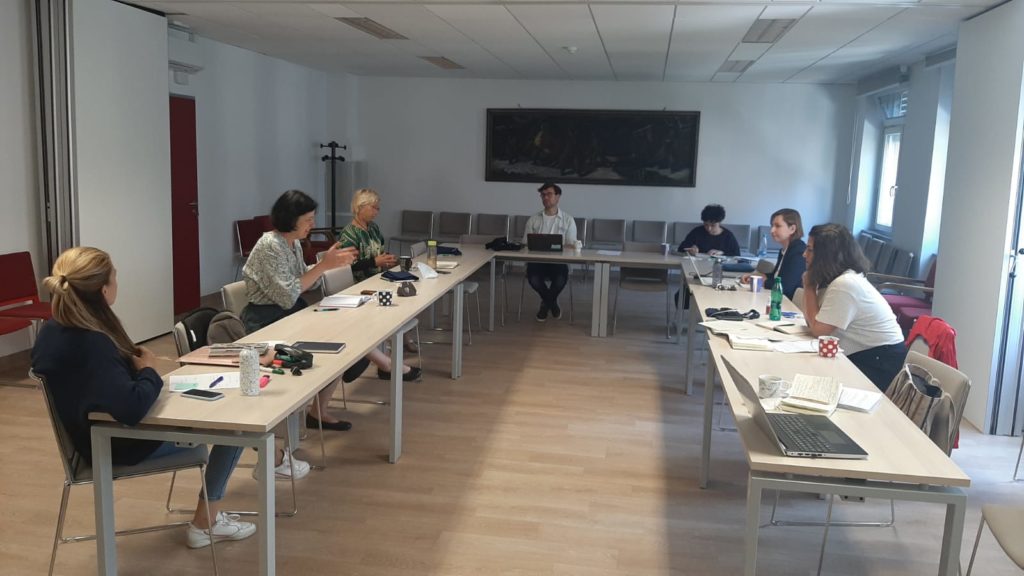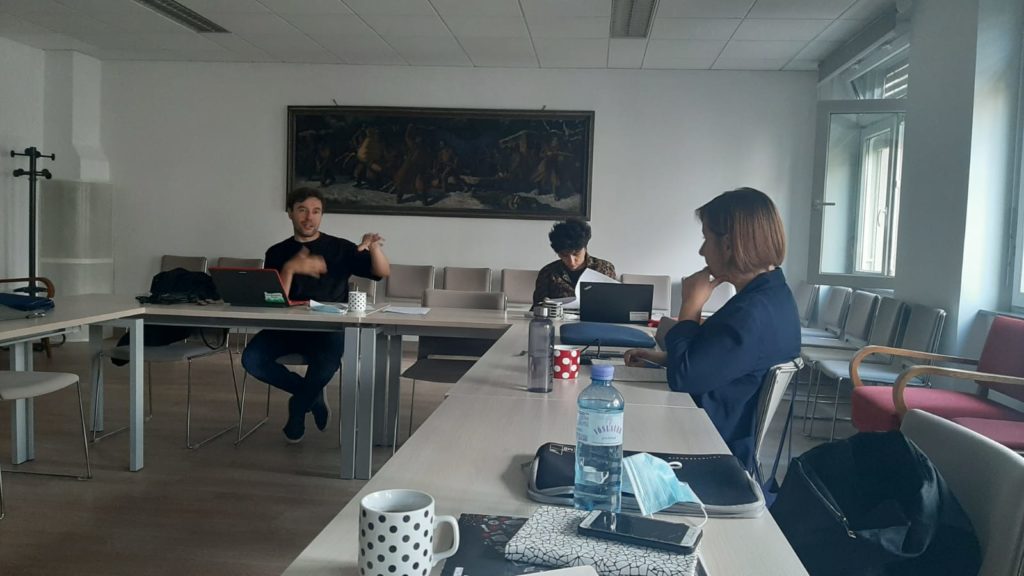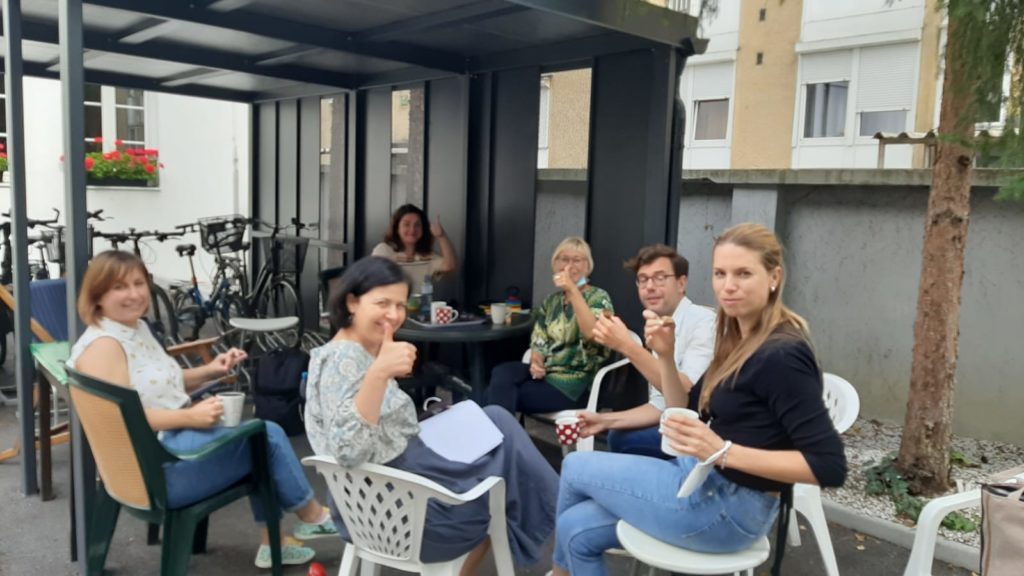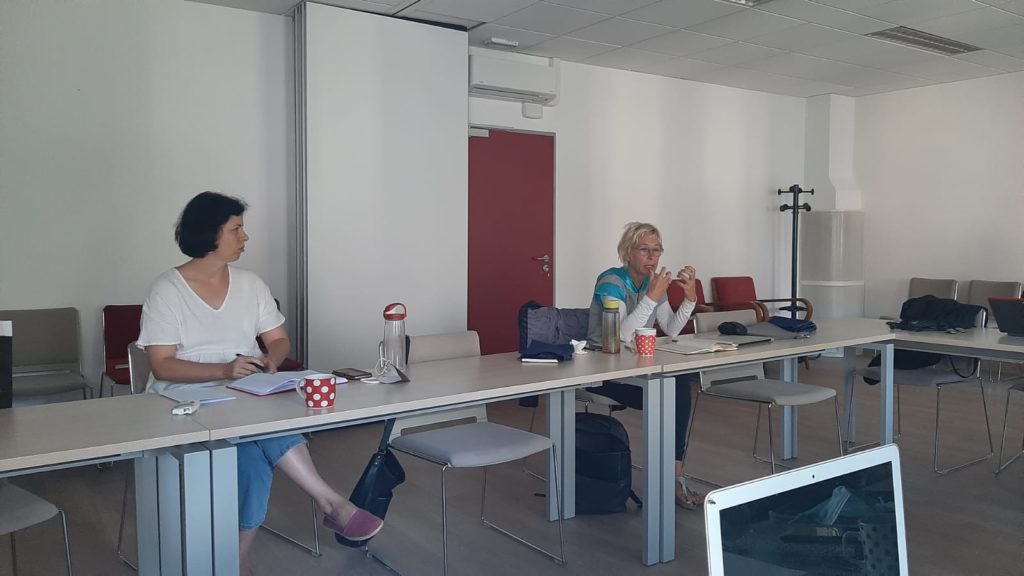21/09/2021
Report: Working Group 2 Ljubljana Meeting
WG2: At the Nexus between Voluntary Action and Public Policies: Rethink Care from the European Periphery
On August 26 and 27, 2021, a two-day international workshop entitled “At the Nexus of Voluntary Action and Public Policies: Rethinking Care in Southeastern Europe” was organized at the Institute of Contemporary History in Ljubljana, Slovenia. The workshop was organized within the framework of the COST Action 18119 Who Cares In Europe?, whose aim is to define and develop an emerging research field that explores the relationships among voluntary associations, families and states in the creation of social welfare in Europe.
This workshop focused predominantly, albeit not exclusively, on the first two categories (voluntary associations and the state), leaving the third one (family) on the background. The workshop organizers, Fabio Giomi (CNRS, CETOBaC, Paris) and Isidora Grubački (CEU, Budapest/Vienna and Institute of Contemporary History, Ljubljana), planned to gather historians which had two features in common: first, currently doing research in the “state-voluntary association ecosystem” in the domain of care, broadly intended, and second, being interested in Southeastern European societies (XIX-XXI centuries). The participants were invited to focus on the methodological and theoretical issues structuring their research endeavour, and to reflect on the following questions: What kind of questions guide your research? What methodological dilemmas did you have to face in the different phases of your research, from archive exploration to writing process? Which are the concepts used to explore the grey zone between state and voluntary action?
This workshop was successful in creating an informal space of reflection on the participants’ research practices. Unburdened from the fatigue of online and hybrid forms, in a professional, yet intimate and friendly surrounding, the participants presented their work and engaged in fruitful discussions about their research interests, methodological dilemmas, and conceptual uncertainties. It proved particularly rewarding that the workshop participants were in different stages of their career, some in the first stages of their PhD research or early post-doctoral years, while others experienced researchers. Hence, an important aspect of the research was an opportunity for the participants to get to know each other and establish future cooperation, which might also lead to further institutional cooperation. For the entire length of the workshop we could also count on the presence and comments of Nina Vodopivec (INZ Ljubljana), who actively contributed to the discussion and also presented her ongoing research.
The workshop encompassed seven presentations, which raised relevant questions concerning voluntary associations as an object of analysis by social sciences. The conversation developed along two main axes: defining and categorising voluntary associations; exploring the porous relationship between voluntary associations and the state.
“What is a voluntary association?”, asked Fabio Giomi. In his paper, Giomi dialogued with the work of the French historian Maurice Agulhon, who already in the 1980s expressed regret about the place that historians, and social scientists more in general, assigned to voluntary associations. According to Agulhon, voluntary associations were mainly studied as a tool for researching various historical processes, for instance the nationalization of the masses or female empowerment, whereas associational culture as such stayed at the margins of the picture. Putting Agulhon’s and other relevant theoretical literature on voluntary associations in dialogue with his empirical research in voluntarism in Croatia, Bosnia and Serbia (1870s-1940s), Giomi proposed a way of thinking beyond the established categories of voluntary action that cannot entirely grasp the richness of voluntary initiatives in various parts of the world, including Southeastern Europe. For instance, challenging the idea of “horizontal membership” of voluntary associations, which implied equality among the members, Giomi pointed to the dynamics of exclusion and inclusion, as well as selectivity and dynamics of hierarchies in different voluntary associations. In search of a novel and more convenient apparatus of categorization, Giomi asked: What do human organisations such as philanthropic organisations, nation-wide gymnastic federations, transnational feminist organisations have in common, operating in different times and places, with different size, goals and agendas? Starting from these questions, Giomi presented the outline of his upcoming research, whose aim is to rethink the existing tools of categorizing in this field.
Jelena Tešija (CEU, Vienna) answered to the workshop framework by discussing her current research on gender and labour history of the Yugoslav co-operative movement from the end of the 19th century to the early 1950s. Focusing on this neglected part of labour history in the Yugoslav lands, Tešija focused on the key conceptual dilemmas and research questions guiding her work on different organizational forms, activist repertoires, agendas, and contributions of women in the co-operative movement. Among other issues, Tešija discussed the diversity within this model of organizing, as well as other aspects of political neutrality, relationship with the state, role in nation-building processes, class alliances, and unity of different types of co-operatives. As she noted, creating a research design that would bring these diverse organizations under the same analytical framework in Yugoslav lands is a challenge in itself. Moreover, she reflected on the conceptual uncertainties of the very term of “zadruga”, which, originating from the term denoting extended patriarchal family, was used for women’s associations in the late 19th and early 20th centuries, and later on for co-operative movements in both the interwar and socialist Yugoslavia. Tešija particularly put emphasis on the complex relationship of the cooperatives with the labour movement on the one hand, and the feminist movement on the other.
Daša Ličen (Institute of Slovenian Ethnology, Ljubljana) tackled the question of charitable associations through the lens of anthropology. By referring primarily to the work of anthropologists Peter Redfield and John Hanson, she challenged the approaches that regard voluntary associations as unconditionally benevolent and liberal, and discussed the often-disregarded class-centred, exclusionary and elite aspects of charitable voluntary associations. In other ways, she shed light on charitable associations as a part of an elite “gift economy”, exclusionary and ritualized. Building her expertise on vast archival research on voluntary associations in Habsburg Trieste, where, as she noted, peopled joined voluntary associations beyond the usually overemphasized national/confessional lines, Ličen discussed the ways how charity was often used to affirm power and reproduce the existing local elite status, as well as to articulate a specific class agenda. Thinking about these issues in a more longue durée perspective, Ličen reflected on the role of charity in postsocialist, but also contemporary pandemic times, and suggested that historical knowledge and anthropological reflections might lead us to rethink contemporary activist practices as well.
In another contribution to the issue of defining specific voluntary associations, Isidora Grubački discussed the categorization of women’s organizations (as opposed to all-male or mixed organizations), particularly focusing on the issue of defining a feminist organization. If a historian was to explore feminist organizations, which organizations should she study specifically, and what kind of categorization should she use? After giving an overview of how historians usually used the term feminism, associating it with autonomy and non-political activism, or characterizing it as bourgeois, reactionary, and even chauvinist, Grubački referred to the lack of comparative literature on the use of the concept of ‘feminism’ in East Central Europe. Consequently, she suggested that, prior to rethinking the existing and/or building a novel categorizing apparatus, it is beneficial to go back to the sources and explore the specificity of the use of this term in the past, specifically in the first half of the 20th century, when the term came to an increased use in the region. Primarily relying on intellectual and conceptual history approaches, broadly understood, she proposed to ask how the concept was used and contested, what were the ideas and other concepts associated with it, and if and how this changed over the period. This exercise, she argued, might further facilitate our understanding on what women who described their organizations as feminist meant, what kind of political statement they made by doing so, how they positioned themselves to other women’s organizations of the time, and what kind of political change came with the conceptual change in this context.
Apart from the questions of defining voluntary associations, which unavoidably raised various other matters as well, another overarching question discussed was the relationship between voluntary associations and the state. Discussing this issue more explicitly, Alex Ghit (CEU, Vienna) proposed to approach women’s voluntary associations with the state and high politics “back in”. As she noted, the existing histories of women’s voluntary associations in South-Eastern Europe are frequently histories of “the excluded” and “the marginalized”, in which middle class women (especially) created for themselves distinct spaces of influence and action, never fully participating politically and therefore never fully involved in state building or complicit in, for example, the abuses of state power. Yet, based on her research on Romanian-language women’s organizing, Ghit proposed to rethink this supposed independence of women’s organizations from empire or state, and to reevaluate them as part of state structures and as aligned with the broader ideological cleavages of their time. Pointing to the activist women’s involvement in electoral struggles and parliamentary debates, their roles of ideologues of nationalism and social reform, their ties to prominent politicians and reliance on public subsidies, involvement in party politics, and the process of professionalization of women’s activists into public sector of social and medical professionals, Ghit posed the question of how to write histories of women’s associational life in Southeastern Europe with “the state back in”, as well as what do we risk overemphasizing and downplaying when researching women’s associational life with some of the tools of political history.
In a rather different way than Ličen, Lucija Balikić (CEU, Budapest/Vienna) further problematized the supposed benevolence and apolitical character of the voluntary associations, by pointing to examples of voluntary associations which either directly contested the state and supported certain political parties, or actively participated in building state-legitimacy. By bringing forward the examples of voluntary associations which compete with the state by providing care only for certain groups, she pointed to an important aspect of care and care-based politics which, in fact, served to facilitate ideological education of their subjects. In her presentation on state, voluntarism, and the body, Balikić creatively proposed a number of concepts to capturing the nexus between state and voluntary association: researching certain voluntary associations as extensions of the state or a political party, researching the ways how voluntary associations create an alternative public sphere or an alternative type of politics – as opposed to the state-promoted one, as well as exploring how the state and voluntary associations competed for citizens’ loyalty.
Bringing the only state-socialist case-study to the workshop, Ana Kladnik’s (INZ, Ljubljana) presentation focused on voluntary practices within the system of Yugoslav socialist self-management at the level of local self-governance in the municipalities and local communities. In her talk, Kladnik explored the possibilities of researching local self-governance in socialist Yugoslavia in comparison with and as one form of a voluntary association. Her case study particularly focused on the municipality of Velenje, a town which experienced a significant and rapid growth in the immediate post-WWII period. To assess the effectiveness of voluntary work, Kladnik used the concept of social capital to investigate the success of policies, the connectedness of inhabitants, as well as various aspects of voluntary work, which was not merely economic but, as Kladnik showed, had a major impact on the life of community. With her presentation, Kladnik opened the question of how to research voluntarism in a state-socialist framework, but also opened an important topic of people’s organizing “from below”. The discussion that followed focused, among other things, on the question of the ways party leaders gained legitimacy for the regime in a local context, which included relying on pre-war popular voluntary associations.
Thus, the issue of labelling, and the relationship of voluntary associations and the state, proved to be the key issues and central dilemmas in the ongoing research on voluntary associations of the workshop’s participants. Regarding the former, while different propositions were made, a general conclusion was that the difference between the categorizations made by historical actors, and those made by historians (in anthropological terms emic/etic distinction) must be intensely reflected upon, and that concepts must not be taken for granted. As proposed by Grubački and Balikić, conceptual-morphological and intellectual history approaches might be useful for this purpose. While in some presentations particular attention was given to understanding how historical actors described their own organizations and associational activities, this was suggested merely as a necessary step for further research of different logics and often huge gaps between descriptions and often rigid classifications on the one hand, and practices on the other.
The state, moreover, proved to be an unavoidable category and point of reference in the research of voluntary associations in Southeastern Europe, beyond the obvious fact that the state is the one that, in fact, registers and approves an association. Regarding the relationship between charitable associations, state, and care, Ličen noted that benefactors can and in fact often do exploit the space that the state leaves empty. Giomi, referring to the huge scholarship on the “mixed economy of welfare”, suggested to explore welfare, but also leisure and education, as an arena where different public and private institutions and actions compete and work with or against one another. In addition, he provocatively stated that each voluntary association had its own ministry, returning upside down the perception of the different kind of alignments between associations’ and the state’s agendas. Therefore, this kind of research might lead not just to a new history of voluntary action, but also to a new history of the state – a history of the state written from its margins, or histories of, metaphorically speaking, the porous borders of the state. An overarching question for further research, as Ghit proposed, taking into account that state can shape voluntary associations and intervene, might be to historicize when did and under which circumstances voluntary associations have greater autonomy in SEE?
Apart from these two overarching issues, several other aspects can be mentioned. While the focus here was on associations in their complex relationship with the state, participants discussed the potential importance of individuals in associational life, pointing to the fact that prominent individuals active in associations, their contributions to the public sphere and the ways they might have contributed to shaping public opinions, as well as their social capital, can be a relevant factor in researching voluntary associations. Moreover, Nina Vodopivec, building on anthropological scholarship, stressed the importance of exploring the place of ethic and morality shaping the engagement of individuals in voluntary action, as well as the complex set of expectations that individuals have in respect of the state. Participants also noted the lack of research of associational life and war in SEE, a topic that seems to be particularly promising. Regarding the politics of associational life, Ghit pointed to the left-wing women’s scepticism towards associational culture, further expanding Ličen’s point about class-based character of voluntary associations. Finally, workshop gave the participants an opportunity to share their experience with the archival sources, and to compare the approaches in finding, for instance, subaltern subjectivities (working class people, women, members of ethnic and religious minorities) in the associational archives. When it comes to researching the relationship between women’s and feminist organizations and the state, Ghit suggested that revisiting associational records with high politics in mind might prove useful.
All participants work on the case studies from Southeastern Europe, a segment of the continent usually considered peripheral both in the scholarships of civil society and welfare, and this workshop proved that these case studies have much to offer. Balikić brought forward the value of researching Southeastern Europe, by pointing to its multi-imperial heritage and, in particular, by bringing forward the notable processes of imperial collapse, founding of the new nation-states and the consequent need for developing public policies pertaining to care in these complex historical contexts. Bringing the case studies from Habsburg Trieste, Ličen showcased the importance and value of researching this area beyond the obvious national and religious dividing lines. The case studies presented by Ghit, Grubački, Tešija, and Giomi, moreover, showed that SEE case studies are valuable for rethinking existing historiographical categorizations and assumptions, whereas Kladnik proposed to rethink voluntarism from a state-socialist perspective.
Finally, the discussion kept coming back to the issue of continuities and ruptures, as well as the similarities and differences between contemporary and past societies. The questions of how to think and write the histories of voluntary associations and its relationship with the state in SEE provided food for thought for contemporary forms of organizing, particularly in the context of paralyzed party politics and, in many contexts of Southeastern Europe and beyond, state capture (see Lucija Balikić, “Summer school reflects on political thinking”, INZ.si https://www.inz.si/sl/Dogodki/Summer-school-reflects-on-political-thinking/) and the lack of effective public policies. Researching past voluntary action unavoidably inspires us to put in a broader perspective, as well as rethink, the (dis)continuities with the state-socialist forms of organizing, the autonomous or state co-opted activism of non-governmental organizations, or, to end with it, the ways our limited involvement in various philanthropic, charitable, or ecological initiatives might serve for making ourselves feel better.
Fabio Giomi and Isidora Grubački










